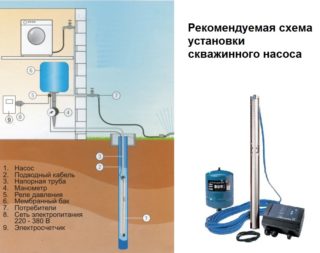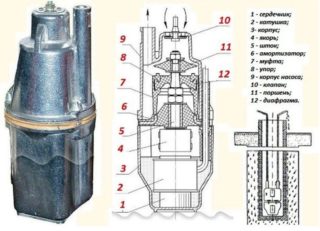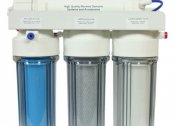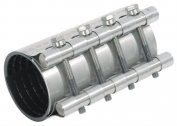Regular water supply of the summer cottage provides comfort to its owners and a stable, good harvest. Most often, for a device of autonomous water supply / irrigation, they dig a well or a well. To raise the fluid, use a submersible pump. A small unit easily copes with large volumes of water per unit time. At the same time, the price of submersible water pumps for summer cottages is quite acceptable.
Scope and device of submersible pumps
As a rule, submersible (deep) units are used to lift water from a well or well. In addition, there is a separate category of devices for a suburban area - drainage (fecal). This group of pumps copes with heavily polluted water and is used to drain flooded rooms, pumping cesspools. These pumps grind impurities with special cutting elements.
Standard depth units are used to supply water to the cottage / cottage or to irrigate the site.
The principle of operation of submersible pumps is that they suck water into the chamber and then transport it through the riser up to the water supply system.
Classification of submersible pumps
All deep water supply units are divided into types according to the type of device and purpose. Depending on the application, well and borehole devices are distinguished. The former are inert to water mixed with particles of garbage. They are sometimes impressive in size and do not fit into the casing. Borehole pumps are suitable for working with the cleanest water and are made in the form of a thin flask. Its diameter is always less than 1-3 cm from the casing section of the well.
Regarding the principle of operation, deep pumps are:
- Centrifugal. These types of units have blades that move at high speed, sucking water, pressing it against the walls of the working chamber and sending it further up the pipe. More often, such pumps are used in the well. They work due to centrifugal force. These devices are several times more productive than submersible vibration pumps, but they are sensitive to impurities in water. Centrifugal apparatuses are often equipped with a cooling system that prevents equipment from overheating.
-
Vibrating. Equipped with a membrane that fluctuates as a result of pressure drops in the working chamber. It, in turn, changes up or down depending on the arrival / decrease of water. The non-return valve periodically opens and closes, contributing to the filling of the working chamber with liquid from the source and the further advancement of water upward. Basically, vibration pumps are used for wells, since in the well they silt the bottom due to constant fluctuations in water. In addition, such a pump creates a lot of noise. In wells, the unit is also not used because of the diameter. If he had entered the casing, the constant vibrations of the apparatus would eventually violate the integrity of the liner walls.
It is advisable not to install the second type of equipment close to the bottom of the well, otherwise it will cause particles of sand, clay to get into the water and supply contaminated liquid to the house.
Criterias of choice
To choose the right submersible pump for the garden, it is important to be guided by such criteria:
- Type of pump (vibrating or centrifugal). The first is ideal for a well, the second is for a well. A centrifugal apparatus can also be placed in a wide source, if the budget allows.
- Performance. It is indicated in the technical passport to the equipment and is calculated in liters / hour.To calculate the required performance for a particular cottage, you need to take into account the number of people in the house and multiply by the standard 10 l / hour. It is also worth adding fluid flow for irrigation. It is approximately 1 m3 per day. It is desirable that the pump has some margin of productivity - approximately 10-15%.
- Device size It is important if the question concerns the well. Any one is suitable for a well.
- Water pressure. Calculated by the formula hs + 0.2L + 30, where H is the column of water according to the passport; hs is the installation depth of the pump from the ground; L is the length of the pipeline from the source to the point of water supply.
- Fluid quality. If the well is very sandy, you need to pay attention to the ability of the pump to pump contaminated fluid.
When choosing a pump for the water supply in the country, it is important to consider the total depth of the source from the surface of the earth to its bottom. Each model is designed for a specific immersion depth. In addition, over time, the primary indicator for the source can change downward due to siltation of the bottom.
Installation steps
 The submersible water unit is mounted in the following sequence:
The submersible water unit is mounted in the following sequence:
- A welded frame is prepared, on which a cable will later be fixed to fix the pump. It is installed on the top of the well or along the edge of the well. The frame can simply be welded from a metal corner.
- Measure the length from the upper estimated nozzle of the unit to the point of exit from the source. A flexible pipe of a given length is cut off. It is laid while on the ground.
- Check the outlet pipe for serviceability and the presence of a check valve. If it is not, then install. After that, mount the coupling (parallel joints are sealed) and connect the pump to one end of the pipe.
- A pump electric cable is stretched along the tube. Here the pull cable is pulled. It is desirable that it be nylon. Steel rusts and breaks over time. One end of the cable is attached to the hooks on the device body.
- The pipe, cable and cord are pulled together with plastic clamps in increments of 20-25 cm. At the same time, free sagging of elements or excessive tension are avoided. Some masters use insulating tape for screed, but this is not entirely hygienic and durable.
- Lower the pump into the source and fix it on the welded frame at the top.
- The pump is plugged in, pre-filled with water in the system, and all the connections are checked for leaks.
Lower the garden machine into the well / well only for the safety cable. Previously, it must be tied to the frame so that during the dive it does not slip out of the hands. It is forbidden to hold the pump by the power cable or pipe while lowering the device.
Submersible Pump Cost
Depth devices change their price up or down depending on the device, power and manufacturer. The average cost of submersible pumps in Moscow:
| Name | Cost (in rubles) |
| Submersible pump "Aquarius" | 8 300 |
| The pump is deep "Belamos" (borehole) | 13 940 |
| Vaos vibration "Stream" | 1 440 |
| Vibrating unit "Patriot" | 1 570 |
| Centrifugal borehole Caliber unit | 5 400 |
| Vibrating country pump "Dzhileks-Kid" | 1 880 |
| Pommel Pump | 1 750 |
For summer use for the purpose of watering the site, you can buy a quite inexpensive depth unit. With careful use, it will last 5 years or more. In addition, the vibration pumps are repairable, you can cope with the repair yourself.





